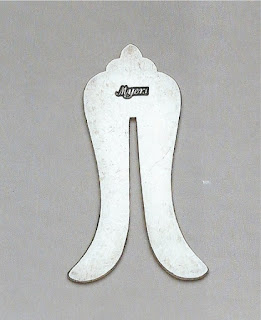Piece of the Month - Circumcision Shield
As mentioned earlier there are six examples of judaica made colonial metalsmith Myer Myers. These are five sets of rimonim (torah crowns) and one circumcision shield. This month’s “Piece of the Month” is my take on Myer Myers circumcision shield. Traditionally, the mohel would take a male infant’s foreskin, pull it through the slit and then, with a double edge knife, slice the foreskin off.
The first question one might ask is why would I make such an item? Could I improve upon its utility? Am I a masochist? Is there a market for this item? No to all of the above. The answer is no more complicated than how would I make this traditional tool my own.
Here’s a photo of Myers’ circumsicion shield.
The piece is silver, 2.625 x 1.5” and weighs 18 dwt. (Barquist, Myer Myers, p. 152) Myers’ mark is centrally located on the piece.
While Myers shape was typical of the period, I used it as a jumping off point for my piece. I kept the same rough dimensions but moved away from the curved nature of Myers work to a design with which I was more comfortable.
As you can see my design is much simpler. The piece is made from 14 gauge (,064”) sterling. Technically there were not many challenges to this piece. The most important being that the inside of the slit was rounded and assuring that there were no sharp edges. (No need to create the possibility of extra pain.) The former was accomplished through the use of crocus tape and then buffing with hard felt points.
A few editorial notes. I am working on a bibliography of post WWII judaica (metal and others) which I will share initial findings in the near future. The next blog, mid-July will deal with the issue of preparing to take the show on the road as I get ready to attend the 2016 Hadassah National Convention Boutique at the end of July..

